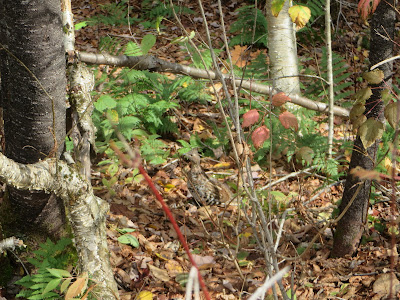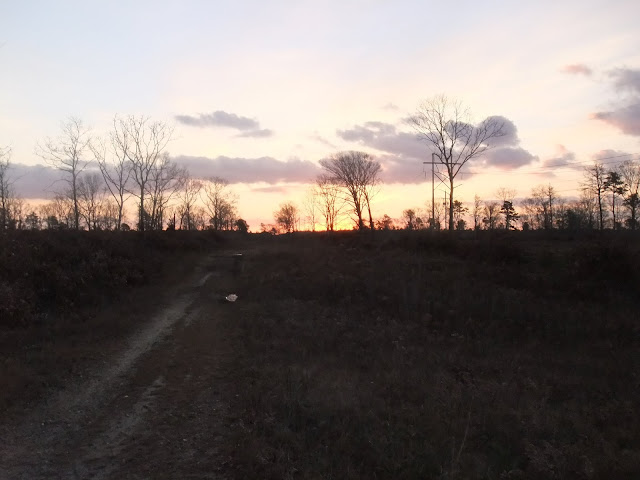The end of
October had arrived and the gang had left. It was prospecting time, which means
searching for new grouse cover. It’s done every year, usually after all the
friends have left. There’s no use dragging them around the wilds to places that
may or may not hold birds. Sometimes the terrain gets mighty rough in our
rugged neck of the woods and exploring what might be birdless cover isn’t
always appreciated. Good grouse cover can go from prime to thin-pickens in
about ten years, so it is always necessary to be prospecting for new coverts.
The clear
cut showed up on Google Earth and was back in a section of country that’s been
full of grouse the last few years. The cut covered probably two hundred acres,
but hid behind a stand of thick softwood trees, so it wasn’t readily visible
from the logging road. All that, and fourteen miles from the nearest asphalt in
some mighty rugged terrain made it seem promising and maybe even un-hunted.
It would be
one of the last hunts of the year, so I let all three dogs out for the hunt. Pandemonium
can be fun. From where we parked a skid trail turned into snowmobile road, wide
as a thruway, that seemed to run upward forever. It passed softwoods to the
left while a stream gurgled in a gully filled with hardwoods to the right.
When the softwoods gave way the cutting looked enormous. We trekked to the top
and an old road continued into the shade of mature hardwoods. The view back across the forested valley was stunning.
 |
| The nearest paved road is over those hills. |
The cutting
probably was two years old with relatively easy walking between the poplar and
maple sprouts. The loggers had taken away all of the tree tops, leaving the
ground relatively clean. Wet spots were covered with grass and moose tracks.
Sprouts crowned the hardwood stumps, but most weren’t shoulder height. Wild
raspberries grew everywhere. It really wasn’t good grouse cover yet.
The dogs
and I hunted along the top of the cutting and then down the west side. It didn’t look too encouraging, with no
softwoods to offer shelter for the birds, but ahead and about halfway down the
slope I could see softwoods left behind by the logging operation.
Approaching,
I noticed a small knoll covered with softwoods.
Now I love
knolls, because grouse love knolls. What better place to sit and collect
morning sunshine and survey the surroundings. No matter which way danger
approaches, the grouse has a downhill escape route that leaves them out of sight
in the blink of an eye.
 |
| Chara on a bird. |
About then
I wished my friends hadn’t all left for those flat lands to the south.
Approaching the hump the dogs’ bells eagerly rang. And then I could hear the
birds accelerating off the far side. There were at least four. If only someone
could have been standing on the far side, it would have been like one of those
European driven hunts.
On the
other side of that little hill the cutting opened up again with scattered
softwood clumps further down the slope. Stopping for a moment, I tried to guess
where I would go if I were a grouse and picked an open alley that led downhill
into a softwood swamp.
At the edge
of the spruce and fir thicket my oldest German wirehair, Chara, locked up on
point, almost completely hidden by young waist-high fir trees.
A bird
busted out wild. Missed. Opening the gun
to reload, a second bird rocketed after the first.
Encouraging
the dogs on, Colby, my youngest wirehair, pointed a grouse sitting about twelve
feet off the ground in a yellow birch.
It flew on my approach, sailing away ahead of a swarm of shot…those
birds coming out of trees are devilishly hard to hit.
The woods
got thicker, with blown down fir trees and nearly impenetrable clusters of
young ones. Pushing through, it was impossible to see my feet. All three dogs became
birdy, pressing under the tangles that I was forced to climb over. Each dog wanted to find the birds first.
 |
Colby coming out of the
thicket with the bird
Georgia pointed. |
I couldn’t
locate Georgia, the young German shorthair, but then spotted her frozen about
eight feet in front of Colby, who was honoring. The thick green fir boughs
almost buried both of them. Before I could get within twenty yards of the dogs
the grouse rumbled upward and a reflex made my gun fire. It was a prayer shot,
but I saw a bird’s wing flutter…maybe. With the softwoods so thick a dead bird might
get caught up in a branch and never hit the grouse. The dogs had disappeared.
And then
Colby came pushing through the brush with the bird in her mouth. What a great
sight.
 |
Georgia checking out the
grouse she pointed. |
We hunted down
the hill, moving three more grouse, but killing none. Coming out of the swamp
into the more open clearcut Chara pointed and a woodcock flew up on my
approach. Twisting among the branches of two fir trees, it quickly escaped.
We went back the next year and I brought my friends. I wish all my prospecting
trips turned out that successful.
 |
The gang, Georgia, Colby, and Chara, taking a break
beside a logging road. |










































